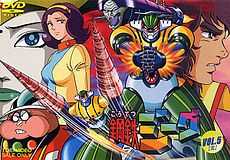Steel Jeeg
| Kotetsu Jeeg | |
|
Kotetsu Jeeg DVD vol.5 | |
| 鋼鉄ジーグ (Kōtetsu Jīgu) | |
|---|---|
| Genre | Mecha |
| Anime television series | |
| Directed by | Masayuki Akechi |
| Written by | Hiroyasu Yamaura, Keisuke Fujikawa, Toyohiro Ando |
| Studio | Toei Doga |
| Network | NET (now TV Asahi) |
| Original run | October 5, 1975 – August 29, 1976 |
| Episodes | 46 |
| Manga | |
| Written by | Go Nagai |
| Illustrated by | Tatsuya Yasuda |
| Published by | Kodansha |
| Magazine |
TV Magazine Otomodachi* |
| Original run | August 1975 – June 1976 |
| Volumes | 2 |
| Notes | |
|
Only a few stories were published in Otodomachi, but they are included in the tankōbon. | |
Steel Jeeg (鋼鉄ジーグ Kōtetsu Jīgu), more commonly known as Kotetsu Jeeg or Koutetsu Jeeg, is a super robot anime and manga series created by manga artists Go Nagai and Tatsuya Yasuda. The anime TV series was produced by Toei Doga. It was first broadcast on Japanese TV in 1975. The series lasted for 46 episodes. Steel Jeeg also ran as a manga in several children's publications.
A sequel series called Kotetsushin Jeeg (which appears to take place 50 years after the original show) aired on the satellite network WOWOW, beginning April 5, 2007.[1]
Story
Hiroshi Shiba is a car racer who is mortally wounded in a laboratory accident, but restored to life by his father, Professor Shiba, a talented scientist and archaeologist, who is incidentally investigating the relics of the ancient Jamatai Kingdom. During his research, Shiba discovers a tiny bronze bell with tremendous powers. Many years later, prof. Shiba is murdered by the henchmen of Queen Himika, the ruler of Jamatai, who intends on seizing the ancient bell and its power.
Hiroshi learns about his legacy soon after his father's death. He was turned by his father into a cyborg, and made capable of transforming into the head of a giant robot, Steel Jeeg. Prof. Shiba also hid the bronze bell in his son's chest. He did all this with the purpose of preventing the Jamatai invasion of modern Japan.
In some battles, Jeeg is also aided by a robot horse known as Panzeroid. The minions of Queen Himika have huge haniwa phantoms buried thousands of years under Japan's soil, and only Jeeg can destroy them and save the world. Therefore, Hiroshi is forced to lead a double life as well as a career as a racer, and, after his father's death, he also has to take care of his family.
Concept
Steel Jeeg is formed by combining the parts released by the Big Shooter jet, piloted by Prof. Shiba's lovely assistant, Miwa Uzuki.
Production notes
The Steel Jeeg anime was broadcast in a number of European countries, where it was quite successful, especially in Italy, where it still has a huge fanbase. In the 80s the series was shown in Latin America, where it was part of a giant robot show fashioned in the style of Force Five, called "El Festival de los Robots" which translates to "Festival of Robots". Steel Jeeg was called "El Vengador" (The Avenger) along with four other anime shows including Gaiking, Starzinger and Magne Robo Gakeen. The names were translated in Spanish to "El Gladiador", "El Galáctico", and "Supermagnetrón" respectively. Like many popular 70s super robot shows, Steel Jeeg has never been released in the US.
Staff
Series director: Masayuki Akechi
Episode Director: Kazuya Miyazaki, Masamune Ochiai, Masayuki Akechi, Yoshio Nitta, Yugo Serikawa
Music: Michiaki Watanabe
Original creator: Go Nagai, Tatsuya Yasuda
Character Design: Kazuo Nakamura
Theme music
Opening theme: "Song of Kotetsu Jeeg" (鋼鉄ジーグのうた Kotetsu Jīgu no Uta), by Ichirou Mizuki with Columbia Yurikago-kai and Koorogi '73
Ending theme: "Theme of Hiroshi" (ひろしのテーマ Hiroshi no Tēma), by Ichirou Mizuki with Koorogi '73
Video games
Jeeg makes an appearance in 2nd Super Robot Wars Alpha and Super Robot Wars Alpha 3 for the PlayStation 2, and in Super Robot Wars K and Super Robot Wars L for the Nintendo DS
Merchandise
Takara made Jeeg and Panzeroid toys as part of their Magnemo line, making use of a system of magnetic sockets and steel ball joints for unprecedented articulation and interchangeability.
In the United States, the Jeeg and Panzeroid toys were remolded in different colors and new heads were sculpted for Mego's Micronauts "Magno" figures; Baron Karza and Force Commander.
In Italy, the toy company Gig Co, who had the European rights to the Micronauts at the time, made three more figures using the Jeeg toy as a basis; King Atlas, Green Baron, and Emperor. These toys (with the exception of Emperor, who was released in very limited numbers by a company called Lion Rock Toys) were never released in America because Mego went bankrupt before the toys could be unveiled to the US market, while Gig kept the Micronauts license going for a few years afterward in Europe.
References
- ↑ Anime!Anime! Staff (2007). "鋼鉄ジーグ 30年ぶりに復活!4月からWOWOWで(1/26)". Anime!Anime!. Retrieved January 26, 2007.
External links
- Steel Jeeg's website at Toei Animation (Japanese)
- JEEG, THE STEEL ROBOT at Toei's corporate website
- Kotetsu Jeeg (Japanese) at allcinema
- Kotetsu Jeeg at Animemorial
- Kotetsu Jeeg (Italian) at the Enciclo'Robopedia website
- Kotetsu Jeeg (manga) (Japanese) at the World of Go Nagai webpage
- Kotetsu Zieg (anime) at Anime News Network's encyclopedia
- A potential realistic interpretation of Dr.Shiba's Steel Jeeg
- 3d Jeeg in CGI (Italian)
